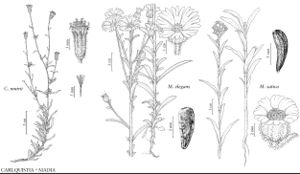Difference between revisions of "Carlquistia muirii"
Novon 9: 463. 1999.
IllustratedEndemicConservation concern
Basionym: Raillardella muirii A. Gray in W. H. Brewer et al., Bot. California 1: 618. 1876
Synonyms: Raillardiopsis muirii (A. Gray) Rydberg
imported>Volume Importer |
imported>Volume Importer |
||
| Line 67: | Line 67: | ||
|publication year=1999 | |publication year=1999 | ||
|special status=Illustrated;Endemic;Conservation concern | |special status=Illustrated;Endemic;Conservation concern | ||
| − | |source xml=https:// | + | |source xml=https://bitbucket.org/aafc-mbb/fna-data-curation/src/2e0870ddd59836b60bcf96646a41e87ea5a5943a/coarse_grained_fna_xml/V19-20-21/V21_740.xml |
|tribe=Asteraceae tribe Heliantheae | |tribe=Asteraceae tribe Heliantheae | ||
|subtribe=Asteraceae (tribe Heliantheae) subtribe Madiinae | |subtribe=Asteraceae (tribe Heliantheae) subtribe Madiinae | ||
Latest revision as of 21:14, 5 November 2020
Leaf blades 9–42 × 2–4 mm. Invo-lucres 8–13 × 5–10+ mm. Disc corollas 6.5–10 mm. Cypselae black, 4–7.5 mm; pappi 5–11 mm. 2n = 16.
Phenology: Flowering Jun–Oct.
Habitat: On granitic soils, openings in forests
Elevation: 1100–2500 m
Discussion
Of conservation concern.
Carlquistia muirii is known only from granitic substrates in the southern Sierra Nevada and Santa Lucia Range (Ventana Double Cone). Major disjunctions among the populations of C. muirii, a self-incompatible tarweed, may be explained by vicariance, ancient dispersal, or both (B. G. Baldwin and D. W. Kyhos 1990).
Selected References
None.
Lower Taxa
None.

